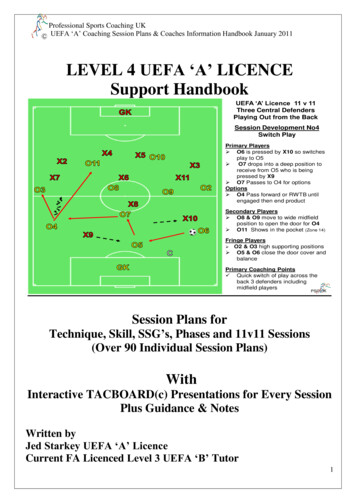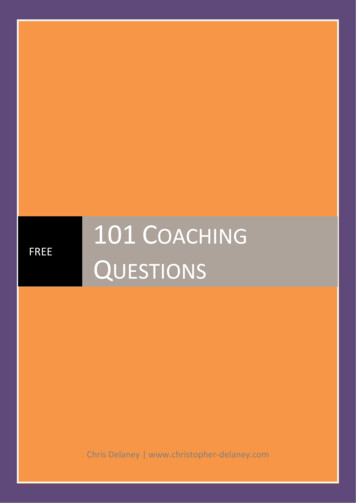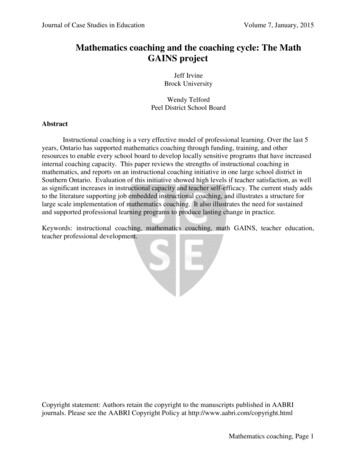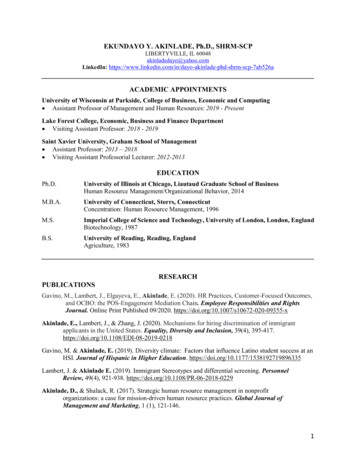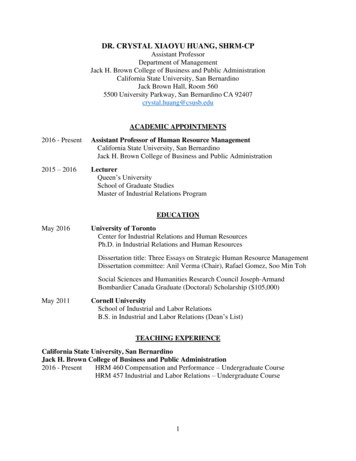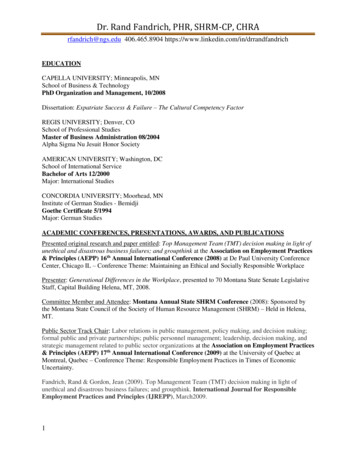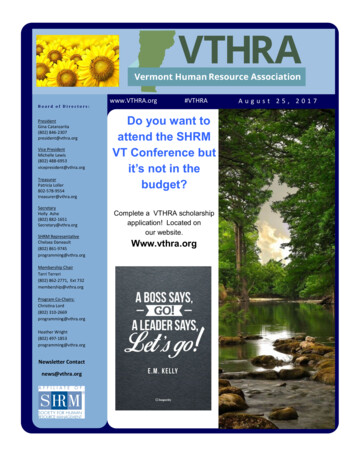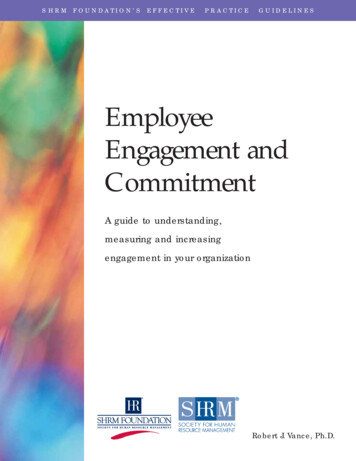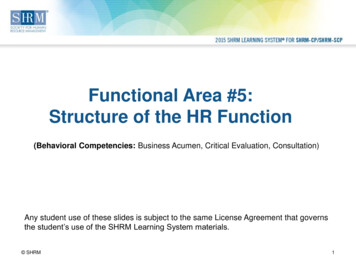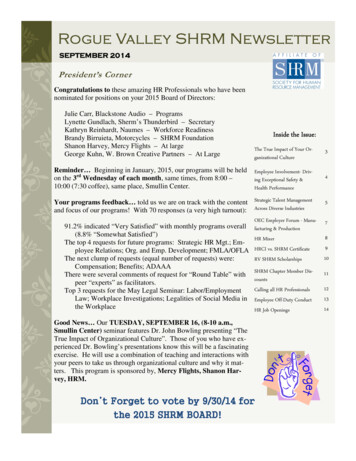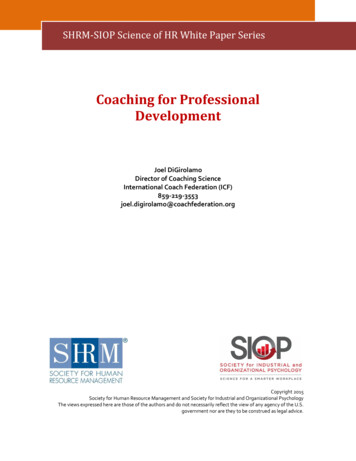
Transcription
SHRM-SIOP Science of HR White Paper SeriesCoaching for ProfessionalDevelopmentJoel DiGirolamoDirector of Coaching ScienceInternational Coach Federation rgCopyright 2015Society for Human Resource Management and Society for Industrial and Organizational PsychologyThe views expressed here are those of the authors and do not necessarily reflect the view of any agency of the U.S.government nor are they to be construed as legal advice.
Joel DiGirolamo is the director of coaching science for theInternational Coach Federation (ICF), where he leads theorganization’s efforts to develop, curate and disseminateinformation around the science of coaching. He has more than 30years of staff and management experience in Fortune 500companies and is the author of two books, Leading Team Alphaand Yoga in No Time at All. Joel holds a master’s degree inindustrial and organizational psychology from Kansas StateUniversity, an MBA from Xavier University and a bachelor’s degreein electrical engineering from Purdue University. He is a member of the Society forIndustrial and Organizational Psychology (SIOP), the Society of Consulting Psychology(SCP), the American Psychological Association (APA) and the Society for HumanResource Management (SHRM).2
ABSTRACTCoaching can be an effective and integral component of leadership development programs.Popular among human resource professionals and clients, coaching facilitates leaders’professional growth and helps to build a powerful team—from executives to first-linemanagers and team leaders. Coaching has a proven track record of success, and many studieshave shown how coaching enhances decision-making skills, improves interpersonaleffectiveness and increases confidence. The maturing workforce necessitates thoughtfulsuccession planning, and coaching is often a strategic element of this effort. Integratingcoaching into an organization’s culture will ensure the longevity and sustained value of theprogram.What Is Coaching?Coaching is a unique endeavor. Coaches partner with clients in a transformativeprocess that empowers and inspires them to reach their maximum potential. Thecoaching process is about movingforward, working with the client tostretch and reach goals he or shedesires. Figure 1 illustrates this concept.The coach provides a stable referencewhile supporting the client in his or herjourney from place or attitude A to B.Fundamentally, it is about facilitating achange or transformation within theFigure 1. Client Journeyclient. Coaching is frequently used to assist individuals as they prepare for or move intonew assignments, improve work habits, adapt to a changing environment or overcomespecific obstacles.3
Coaching is often confused with other personal or organizational supportmodalities, such as mentoring, consulting and psychotherapy. In a mentoringrelationship, an expert provides advice and counsel based on his or her wisdom orexperience. A consultant gives advice (usually of a business or technical nature),diagnoses problems and designs solutions. Psychotherapy involves healing pain,dysfunction and conflict, often with a focus on resolving past difficulties or healing oldwounds.Making the Case for CoachingAcademic research and organizational evaluations have demonstrated theeffectiveness of professional coaching. A meta-analysis of 18 quantitative studies oforganizational coaching showed that coaching has a significant effect on performance,skills, well-being, coping, attitudes and self-regulation (Theeboom, Beersma, & vanVianen, 2013). Meanwhile, managers and leaders at organizations where coaching isused have reported a host of positive effects, including improved team functioning,increased engagement, improved employee relation and increased commitment(Human Capital Institute & International Coach Federation, 2014).Decisions on how to measure coaching effectiveness are sometimes contentiousand often difficult. Return on investment (ROI) calculations are sometimes used toachieve a hard number illustrating money saved through measures such as increasedproductivity and reduced turnover. In a 2009 global study commissioned by theInternational Coach Federation (ICF), of 2,165 respondents 40% indicated that their4
organization had experienced financial changes as a result of coaching. Based upon asample of respondents who provided detailed results, it is likely that more than half ofthese changes were positive (International Coach Federation, 2009).Usually, 360-degree surveys administered before coaching begins and again severalmonths after the coaching engagement ends provide a clear picture of the progressmade. These assessments, however, can be tedious to arrange and expensive toadminister.Measuring the nonmonetary benefits of coaching is even more difficult. Manyorganizations use return on expectations (ROE) measurements to quantify thesebenefits. An organization might measure ROE by assessing changes in clients’ selfreported ability to achieve their goals. Examples of goals might include increasing selfconfidence, improving interpersonal relationships or enhancing work performance.Some organizations prefer even simpler measures, such as asking clients if they felt thecoaching was worth their time, whether it made a positive change and if they wouldrecommend it to a colleague. DependingThe coaching process ison the need, such simple measures mayabout moving forward,be sufficient justification to continue acoaching program.working with the client tostretch and reach goals heor she desires.5
Elements of CoachingCoaching is generally considered a recent phenomenon in the business realm;however, as Figure 2 illustrates, it can trace its roots to many fields, including theHuman Potential Movement (HPM) of the 1960s, philosophy, business and humanisticpsychology, among other traditions (Stein, 2003; Brock, 2008). The HPM andassociated Large Group Awareness Training (LGAT) programs attempt to enhanceindividual self-awareness, facilitate growth and inspire individuals to seek their fullpotential (Finkelstein, Wenegrat, & Yalom, 1982). The HPM and, subsequently,coaching were influenced by humanistic psychology pioneers, including Carl Rogersand Abraham Maslow (DeCarvalho, 1991; Brock, 2008) and influential business writerssuch as Dale Carnegie andNapoleon Hill (Brock, 2008).Carl Rogers was one ofthe founders of the field ofhumanistic psychology. Heemphasized the need tofocus on and maintain apresence with the client(Rogers, 1957). AlbertBandura, a socialpsychologist, provided aFigure 2. Influences on Coachingsignificant contribution to6
coaching with his theory that behavioral change may be a result of conscious, orcognitive, thought rather than an immediate reaction to present circumstances(Bandura, 1982). The self-motivation to change and develop a life that fulfills and bringshappiness to the individual was theorized by Abraham Maslow (Maslow, 1943) andheavily influenced the HPM (Brock, 2008).More recently, the field of positive psychology has moved away from the focus onmentally unhealthy behaviors to mentally healthy behaviors. This field, promoted byMartin Seligman and others, concentrates on happiness and how to flourish in life,bringing greater satisfaction to individuals in all aspects of their lives (Seligman &Csíkszentmihályi, 2000).Self-improvement professionals Dale Carnegie and Napoleon Hill promotedbehavioral changes in order to achieve success in both business and personal aspects oflife (Carnegie, 1936; Hill, 1937). The essence of the books and programs by Carnegie andHill—that one can be successful by envisioning and persisting toward goals—wasadopted by the HPM and coaching in general (Brock, 2008).Philosophy has also played a role in the development of coaching. Easternphilosophy promotes the need to look at the big picture and search for balance andharmony; Western philosophy seeks to understand contradictions, reality and ways tomaster it (Brock, 2008). Many of these philosophical approaches have influenced orbecome integral to different types of coaching.7
Theories or models of human behavior frequently provide frameworks within whichcoaches can engage with clients. Diving deeper into the engagements, coaching toolsand techniques can be observed (Herd & Russell, 2011).Coaches will frequently use one of these frameworks or models. Experiencedcoaches often have many frameworks and models at their disposal and either chooseone or integrate elements from multiple frameworks to provide an effective structurefor each specific engagement. Coaches may also use tools such as objectiveassessments and techniques such as role-playing and journaling within their chosenframework.FrameworksThe framework or conceptual model a coach uses can be a guide for discussions andmay lead to specific activities. A framework provides structure and focus for thecoaching engagement.The client-centered, or people-centered, approach is one of the earliest and mostsignificant approaches. Pioneered in the 1940s and 1950s by psychologist Carl Rogers,the approach is based on the belief that all people have the ability and tendency towardgrowth and optimal function. Rogers wrote that it was necessary for the individualassisting the client to fully understand the client’s situation from an emotionallycentered place and communicate this back to the client for him or her to process anddevelop (1957). A client-centered approach to coaching entails supporting clients todevelop goals they are passionate about and continually guiding the dialog and process8
toward meeting those goals. Client-centered coaching engages the internal drive ormotivation of the client, which is almost always more powerful and long-lasting thanexternal motivation (Deci, Koestner, & Ryan, 1999; Bénabou & Tirole, 2003).The strengths-based approach began in the field of management thanks tobusiness guru Peter Drucker (1966) and subsequently Donald Clifton of Gallup (Clifton& Nelson, 1992). This framework emphasizes the identification and use ofpsychological strengths. Drucker believedthat building on strengths is one of thefive essential practices of an effectiveNo matter what frameworkor model is used, it isimportant that coaches areexecutive. Clifton’s idea was to create aallowed flexibility to adapt toclassification for strengths and positivewhatever comes up inbehaviors, rather than for psychologicalcoaching sessions.issues as described in the Diagnostic andStatistical Manual of Mental Disorders. Building on strengths feels intuitive, promotesconfidence and enhances the idea of continuously moving forward. A few key strengthscan overcome a plethora of weaknesses. The inherent difficulty in this approachbecomes evident when the strengths are insufficient to be effective or when theweaknesses overwhelm the strengths. Objective assessments such as the Values-inAction (VIA) Strengths Finder (www.viacharacter.org) are useful in identifyingstrengths. In addition, a proficient coach will be able to detect strengths through overtclient statements and actions as well as nuances in emotion and body language.9
The GROW model was popularized in the coaching industry by Sir John Whitmore inhis 1992 book Coaching for Performance: GROWing Human Potential and Purpose.Several versions of the GROW model exist; however, Whitmore’s acronym stands for: Goals. Reality, or current reality. Options. Way forward, or what you will do.The GROW model is popular in organizations because it standardizes the coachingframework while allowing leeway for creativity and exploration. Research has shownthat development of appropriate goals can significantly enhance job performance(Locke & Latham, 1990). This model may prove effective in a goal-orientedorganizational setting but may not be helpful in situations when discovery orexploration is required.No matter what framework or model is used, it is important that coaches areallowed flexibility to adapt to whatever comes up in coaching sessions. Upon noticingthat the current model or technique is not working, an effective coach will internallyreflect, evaluate, allow for silence and openly explore new or alternate paths forward.Tools and TechniquesCoaches frequently use tools such as assessments to bring a measure of objectivityand structure to the coaching engagement. A 360-degree survey is a popular10
assessment to accompany coaching. These surveys gather input on the client fromsuperiors, subordinates, peers, and sometimes customers, suppliers and familymembers. Because 360-degree surveys provide a wide variety of perceptions, theygenerally offer many angles from which to approach the work. Given that the surveysreport opinions and perceptions but not facts, they can also bring out the ramificationsof a client’s behaviors—the effects he or she has on others.Personality assessments provide insight into factors promoting an individual’sbehaviors. Well-validated instruments based upon the Five-Factor Model (McCrae &Costa, 1987) are especially detailed. A personality report combined with a 360-degreereport can provide a significant amount of analytic data to guide the dialog in pursuit ofthe client’s goals.Goal Attainment Scaling (GAS) (Spence, 2007) is a method in which goals aredeveloped with rating scales for each goal to enhance motivation and provide ameasure of progress. Other tools coaches use frequently include emotional intelligenceassessments and leadership inventories.It is important to ensure that the personAcademic research andinterpreting an assessment report is properlyorganizationaltrained and also to determine to what extentevaluations haveassessment results will be shared with thedemonstrated theclient’s management team and humanresources department.effectiveness ofprofessional coaching.11
Coaches will often use techniques such as role-playing, simulations, case studies orjournaling. These techniques promote awareness or provide skill practice in a specificarea. Role-playing and simulations can provide good practice and may help a client in anew position or prepare a client for a future role. Case studies are also effectivemethods of practicing for scenarios that may play out in the future. Journaling can helpclients gain awareness of emotions and behaviors, observe events throughout the day,and track progress toward goals.Coaching Within OrganizationsJust as each coaching relationship is unique, no two organizational coachinginitiatives look alike. Table 1, which summarizes key findings from HCI and ICF’s 2014research on coaching within organizations, illustrates some of the factors affecting anorganization’s decision to employ external coach practitioners, internal coachpractitioners, managers or leaders who use coaching skills in interactions with theirsubordinates and peers, or some combination thereof.Organizations use coaching primarily as a component of their leadershipdevelopment strategy. They also use coaching to improve communication skills andteamwork, and to increase employee engagement and productivity.Coaching sessions with an external coach tend to be less frequent, usually once amonth. External coach practitioners are perceived to have a higher level of training andexperience than internal coaches, a more objective view of circumstances, and a better12
ability to coach executives and maintain confidentiality. External coach practitionersare also seen as having a higher price tag than internal coaches.Coaching sessions with an internal coach tend to be more frequent than those withan external coach. Internal coaches are perceived to be more familiar with theorganizational culture and operations, have more access to corporate resources, and bemore able to enhance the development of a coaching culture.Occasionally coaching will be encouraged for an individual struggling with lowperformance. In these instances, all parties involved—the client, his or her supervisorand HR—must have a clear understanding of what information will be shared amongstthem. This should be described in the written coaching agreement between the clientand the coach.Team leaders and first-line managers use coaching skills as frequently as daily.Although their primary role is that of a leader or a manager, they must possesssufficient coaching skills to be successful in developing their subordinatesprofessionally to help them achieve maximum potential.Teaching managers and leaders effective coaching skills can go a long way towardimproving the overall performance of an entire organization. Because these individualshave a more intimate working relationship with their clients, they may use coachingskills on a more informal basis than a professional coach practitioner would.Team leaders, managers and those higher up the corporate ladder will often engagewith a professional external or internal coach practitioner to focus on specific goal13
areas, such as overall job performance, communication skills, interpersonalrelationships or engagement.Table 1. Coaching ModalitiesType itionerManagers orLeadersUsingCoachingSkills% ofOrganizationsThat Offer53%50%82%Top ThreeReasonsfor Using Top egy Improvecommunication skills Top ThreePerceivedDisadvantagesLevel of coachtraining orexperience Cost Knowledge ofcompany cultureAbility to coachexecutives Improve teamwork Knowledge ofcompany politicsMaintainingconfidentiality Leadershipdevelopmentstrategy Knowledge ofcompany culture Increase employeeengagementAccessibleresource to theorganizationLevel of coachtraining orexperience Role clarity Improve teamwork Development ofcoaching cultureMaintainingconfidentiality Leadershipdevelopmentstrategy Knowledge ofcompany culture Increase employeeengagementDevelopment ofcompany cultureLevel of coachtraining orexperience Maintainingconfidentiality Increase productivity Role clarity Knowledge ofcompanypersonnel andoperationsNote. Adapted from Building a Coaching Culture by Human Capital Institute & International Coach Federation, 2014,p. 8, 9, 12. Copyright 2014 by the Human Capital Institute.Coaching CompetenciesMany coaching organizations, including the European Mentoring and CoachingCouncil (EMCC) and the ICF, have developed coaching competency models. Applying14
these competencies ensures effective coaching on a basic level. While the models differin detail, they frequently contain the following core components: Ethics. Developing a coaching agreement. Creating a relationship. Presence, effective communication and questioning skills. Setting goals. Promoting growth. Action.A set of competencies provides a structure for learning how to become an effectivecoach and is also useful in developing assessments. Some coaches set goals to earncredentials from coaching organizations, and defined competencies aid in creating validreliable assessments. For example, ICF has developed a set of markers based upon itsset of competencies that is used to assess coach performance (International CoachFederation, 2014).EthicsA coach should understand the ethical issues related to the coaching profession andvow to follow a comprehensive set of ethical standards. Organizations using coachingshould remain steadfast in their quest for all parties to maintain those high ethical15
standards. A lapse in ethics by a coach can not only harm the coach and the client, butalso sully the reputation of the coaching industry.While ethics in the coaching field certainly includes maintaining confidentiality anda professional relationship with the client, on a broader scale, it is also important for acoach to represent the function and himself or herself accurately and honestly. As inany field, disparaging fellow professionals is ill-advised.Coaching AgreementIt is very important for coaches and clients to have a common understanding of thecoaching engagement and to document this in a written agreement. These agreementsfrequently include the following elements: Confidentiality. Involvement of others, such as HR and superiors. Goals. Engagement duration. Session duration, times and dates. Medium of communication. Client’s recognition of need to change and commitment to change.Because the coaching relationship is an intimate partnership, it is essential thatclients understand which aspects of the engagement will remain confidential to thepartnership. It is best to write out which, if any, aspects of the engagement will be16
shared with other individuals in the organization.Such agreements may also touch on legal andethical grounds for a breach in confidentiality,Coaching Agreements Understanding of what will beconfidential and what will not.such as a court order or threat to harm oneself or others.Typically, the organization will be paying forsuch as HR and superiors. High-level coachingengagement goals.the coaching, and organizational decision-makerswill thus feel entitled to at least a superficial levelHow involved others will be, Estimated duration of thecoaching engagement.of understanding of what is taking place in the coaching engagement. A commissioning HRgeneralist or superior will often request a reportfrom the coach once or twice during anengagement. It is essential that the agreementSession times and means ofmeeting. An understanding of theclient’s view of the need tochange and commitment tochange.detail the elements of the discussions that will bereported to ensure that everyone is on the same page.Describing the goals of the coaching engagement in the agreement serves twopurposes: it provides visual, concrete goals and assists in communicating the goals withothers in the organization if the agreement is shared.Coaching engagements may stretch from one session to many years. It may bedifficult to tell how long the engagement will take, but it is best to indicate at least arange of time in order to set common expectations regarding the investment of timeand money.17
A coaching agreement should also include information about when, where and viawhat medium (telephone, videoconference, face to face) coaching will take place. Theclient should be comfortable with the medium and the location. For example, a clientmay wish to keep the fact that he or she is being coached confidential and prefer tomeet in a private setting. A general, upfront agreement on the logistics of theengagement can go a long way toward building trust and rapport.Because coaching is a client-driven process, a client’s view and attitude willdetermine the success of the engagement. If a client views his or her need to change ashigh and commitment to change as high, it is more likely that the engagement will be asuccess. An upfront discussion of these factors—and their incorporation into thecoaching agreement itself—can help build a foundation for success.Creating a RelationshipThe coach-client relationship between the coach and the client is one of the mostsignificant factors in a successful coaching engagement (Baron & Morin, 2009). Astrong coaching relationship will facilitate growth and inspire the client. The clientshould feel supported by the coach as well as safe in the knowledge that theirconversations will be private and free of judgment.In the organizational coaching context, this process begins with the decision-makercharged with pairing coaches and clients. It is crucial for this decision-maker to giveeach client the right to select or at least refuse a specific coach.18
It may take many sessions for a coach-client relationship to develop. An effectivecoach understands that the effort to build a relationship is as important as undertakingtasks.Presence, Communication and QuestioningWhen a coach is present with the client, his or herThe client should feelsupported by thefocus will remain solely on the task at hand, lookingthe client in the eye and remaining open to whateverarrives in the sessions. A coach must be adaptable inorder to respond most appropriately and withcoach as well as safe inthe knowledge thattheir conversations willbe private and free ofwhatever will be most helpful to the client in thatjudgment.moment. An effective coach is confident in his or herabilities and can convey that confidence in a humble and assuring manner.Communication is at the heart of the coaching relationship, whether it becommunication through words, body language or intonation. An effective coach usesall of these elements to convey a genuine interest in partnering with the client tofacilitate growth. Active listening skills and inquisitive inquiry are valued elements of asuccessful coaching engagement. Questions that reveal beneficial information to thecoach and the client are powerful tools in the coaching process.Goals and GrowthGoals that stretch the client are powerful motivators (Locke & Latham, 1990). Easyto-reach goals are not helpful because the client will readily vault low hurdles. On the19
other end of the spectrum, goals that are unobtainable will lead to frustration andresignation, and may affect the way coaching is perceived by the client and theorganization. Deep and open discussions will facilitate the creation of goals thatpromote growth within the client and provide the greatest value for all parties involved.It is important for the goals to be generated by the client. A proficient coach willsupport the client in developing meaningful, succinct goals. Many clients find so-calledSMART (specific, measurable, actionable or achievable, realistic or relevant, and timebound) goals useful.ActionWithout action, coaching may be viewed as a series of nice, deep conversations.Supporting the client in developing an action and accountability plan will greatlyenhance the chance of long-term success and value.As actions are completed, they build a sense of accomplishment in the client thatcan lead to a willingness to take on and achieve more difficult goals. In addition, asactions are carried out, new ideas and values are sometimes uncovered that bringfurther insight into issues relevant to the coaching engagement.Training and CredentialsCoaches can obtain training through many channels. As summarized in Table 2,each type of training comes with its own advantages and disadvantages. Largeorganizations will frequently prepare their own training in order to reduce cost or tocustomize the training to their values, culture and industry. In order to take advantage20
of coaching expertise, many organizations contract with coaches or coach-trainingprograms to assist with curriculum development and/or delivery.Third-party accredited training programs such as those accredited by ICF and EMCCare beneficial because the developers are steeped in the competencies required foreffective coaching and are held to a standard necessary to ensure the coaches will bewell prepared. Accredited training also prepares coaches to pursue credentials, shouldthey desire to do so.At the university level, many training programs will award coaching students with acertificate or a degree upon completion. Programs in the Graduate School Alliance forEducation in Coaching (GSAEC) have committed to a high standard of education fortheir students.Table 2. Advantages and Disadvantages of Types of Training ProgramsType of TrainingAdvantagesDisadvantagesIn-house developed trainingLow cost, control of curriculumDoes not take advantage ofcoach training experts, moredifficult for coaches to earncredentialsIn-house developed training inconsultation with coachtrainersLow costMore difficult for coaches toearn credentialsThird-party accreditedtrainingComprehensive, easier forcoaches to earn credentialsHigher cost, less control ofcurriculumGraduate school programsDepends upon the programHigh costIn addition to education, many coaches set a personal goal to earn credentials froma coaching organization. A credential often brings personal satisfaction to the coach21
through the recognition of some level of mastery and affirms to clients andorganizations that the coach takes this role seriously, has acquired knowledge in thefield and has demonstrated proficiency at some level.The Role of Coaching in Succession PlanningSuccessful organizations are intentional in ensuring the long-term viability of theirleadership team. Identifying and developing employees who can fill significant roles inthe future is a key element in this strategy. Because coaching is an individualizedintervention providing one-on-one feedback that can quickly be implemented,practiced and honed, it is well-suited to succession planning and leadershipdevelopment.Coaching future leaders can help themWhere to Learn Morebuild confidence and skills they might nototherwise develop. Individualized attention www.associationforcoaching.comin coaching will bring a laser-sharp focus onunique strengths and growth opportunities. Coaching also helps keep leaders active andEuropean Mentoring & CoachingCouncil (EMCC): emccuk.orgAs individuals move into new roles,coaching can support their transition.Association for Coaching: International Coach Federation (ICF):coachfederation.orgengaged in their own professional andpersonal development.22
The more that coaching is embedded into the culture of an organization, the morethoughtful and mature it grows. Coaching philosophy, standards and policies may bedeveloped after reflective dialog on the role of coaching in the organization (Riddle &Pothier, 2011).23
ReferencesBandura, A. (1982). Self-efficacy mechanisms in human agency. American Psychologist, 37(2),122-147.Baron, L., & Morin, L. (2009). The coach-coachee relationship in executive coaching: A fieldstudy. Human Resource Development Quarterly, 20(1), 85-106.Bénabou, R., & Tirole, J. (2003). Intrinsic and extrinsic motivation. The Review of EconomicStudies, 70(3), 489-520.Brock, V. G. (2008). Grounded theory of the roots and emergence of coaching. (Unpublisheddoc
Coaching can be an effective and integral component of leadership development programs. . Statistical Manual of Mental D
